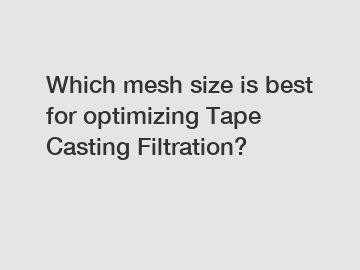Which mesh size is best for optimizing Tape Casting Filtration?
Tape casting is a widely used technique in the production of advanced ceramics and thin films. It involves the deposition of a ceramic slurry onto a flexible substrate or tape, followed by drying and sintering to obtain the desired product. One critical step in this process is the filtration of the slurry to remove oversized particles, which can lead to defects in the final product. The choice of mesh size for the filtration plays a crucial role in optimizing the tape casting process.
To determine the best mesh size for tape casting filtration, several factors need to be considered. First and foremost, the size distribution of the ceramic particles in the slurry needs to be assessed. This can be done through techniques such as laser diffraction particle size analysis or microscopy. Once the size distribution is known, it is important to select a mesh size that effectively removes particles above a certain threshold while allowing smaller particles to pass through. This ensures that the slurry is free from oversized particles that could cause defects in the final product.

In general, a smaller mesh size will provide a higher level of filtration, removing a greater percentage of oversized particles. However, this also means that smaller particles may be trapped by the filter, resulting in a loss of desirable material and potential changes in the slurry's rheological properties. Therefore, it is crucial to strike a balance between filtration efficiency and minimal loss of valuable material.
The choice of mesh size also depends on the desired thickness of the cast tape. Larger mesh sizes may introduce more defects and imperfections in the tape due to the presence of oversized particles. On the other hand, using a very fine mesh can lead to clogging and reduced filtration efficiency, resulting in lower quality tapes.
Furthermore, the choice of mesh size can have a significant impact on the overall process efficiency and cost. A finer mesh requires more frequent replacements due to clogging, which increases downtime and material waste. On the other hand, using a coarser mesh may result in more post-processing steps to remove residual oversized particles, adding to the overall production cost.
In conclusion, the choice of mesh size for optimizing tape casting filtration depends on the size distribution of the ceramic particles, desired tape thickness, process efficiency, and cost considerations. Striking a balance between filtration efficiency and minimal loss of valuable material is crucial. It is essential to evaluate the specific needs of the tape casting process and experiment with different mesh sizes to determine the optimal solution. To maximize the quality and efficiency of tape casting, careful consideration and optimization of the mesh size are necessary.
If you are looking for more details, kindly visit Machinable Ceramic Foam Filter, ceramic foundry filter, Corrosion Resistance Fiberglass Filter Mesh.



Comments
Please Join Us to post.
0